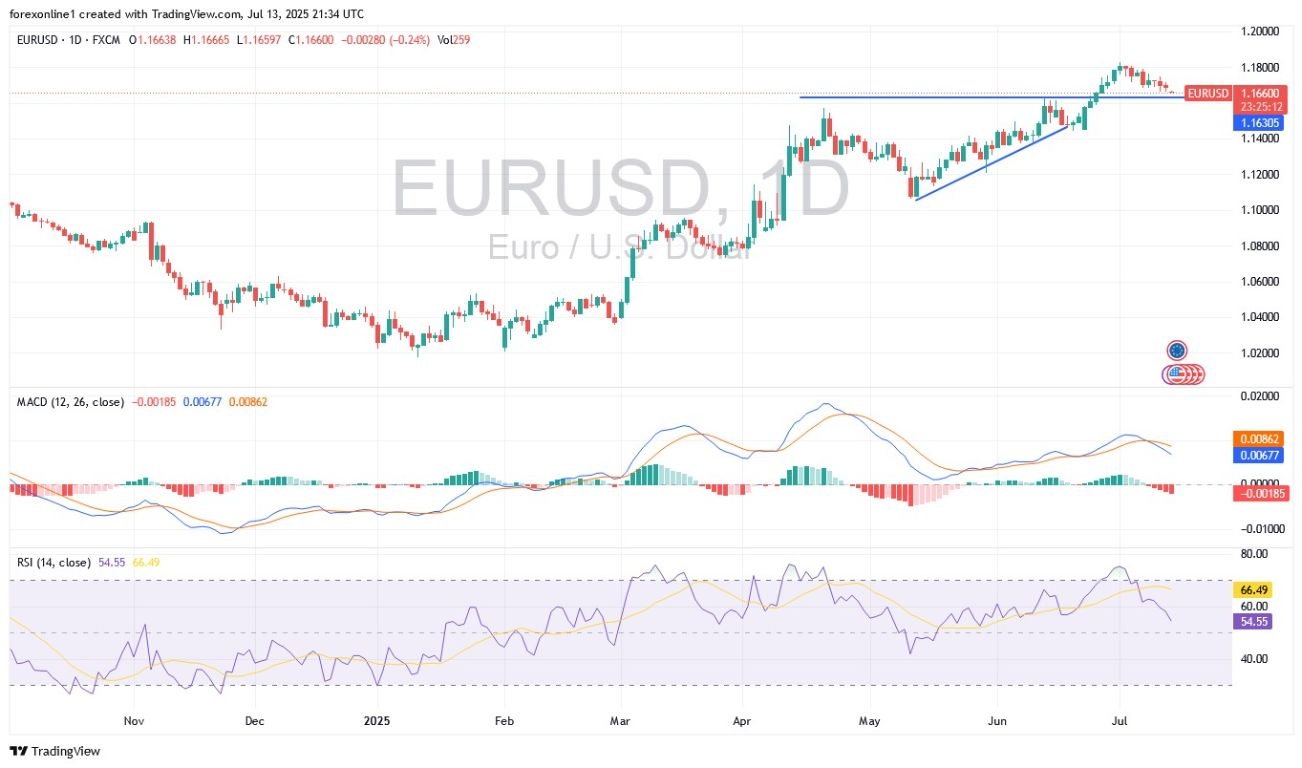EUR/USD Analysis Summary Today
- Overall Trend: Beginning a bearish inclination.
- Today’s EUR/USD Support Levels: 1.1640 – 1.1580 – 1.1500.
Today’s EUR/USD Resistance Levels: 1.1700 – 1.1780 – 1.1840.

EUR/USD Trading Signals:
- Buy EUR/USD from the support level of 1.1570 with a target of 1.1700 and a stop loss of 1.1500.
- Sell EUR/USD from the resistance level of 1.1720 with a target of 1.1600 and a stop loss of 1.1780.
EUR/USD Technical Analysis Today:
The EUR/USD pair is starting the week on a negative note, with the Euro price stabilizing around 1.1660 at the time of writing this analysis. Recently, the US Dollar has gained strength against other major currencies, despite President Trump’s continued imposition of counter-tariffs on other global economies, which threatens the future of global economic recovery.
According to the daily timeframe chart, trading the EUR/USD below the 1.1620 support level would signal the beginning of a break in the bullish trend, thereby preparing for stronger bearish breakthroughs. The 14-day RSI (Relative Strength Index) is approaching the midline, supporting bearish control. At the same time, the MACD (Moving Average Convergence Divergence) indicator lines are beginning to turn downward. Today’s EUR/USD trading is not anticipating any significant economic releases from either the Eurozone or the United States. Investor sentiment regarding the future of US trade wars, particularly against the European Union and China, will remain the most influential factor on EUR/USD performance.
” class=”fui-Primitive ___16zla5h f1oy3dpc fqtknz5 fyvcxda” dir=”auto” id=”content-1686574122635″>
Meanwhile, a bullish scenario for the EUR/USD depends on the currency pair returning to the vicinity of the 1.1760 resistance again. For now, the bias remains bearish until further notice.
European Stock Prices Negatively Affected by Tariff Fears
According to recent trading on stock trading platforms, European stock indices closed sharply lower on Friday amid expectations of decreased global trade flows. The STOXX 50 index closed down 1.1% at 5,380 points, while the broader STOXX 600 index fell 1.1% to close at 547 points. Reports indicated that the European Commission is close to receiving a formal letter from US President Trump regarding tariffs, which imposes duties on the EU, thereby reducing demand from key foreign customers for major European companies.
This came after Trump announced the imposition of a 35% tariff on Canadian imports starting August 1, and signaled plans for comprehensive tariffs ranging from 15% to 20% on most other trade partners.
According to trading on trusted trading platforms, losses were spread across most sectors. Shares of LVMH, Kering, and Stellantis each dropped by about 4%, while UniCredit, BBVA, and Nordea fell by more than 2%, leading the decline among banks. Despite Friday’s retreat, the STOXX 50 index closed the week up 1.7%, while the broader STOXX 600 added 1%.
Trading Advice:
Monitor the strength of the current bearish shift in EUR/USD and wait for signs of strength from both bears and bulls to control the direction in the coming days.
Euro Price Strength and the Future of Interest Rates
In this regard, a member of the European Central Bank indicated that monetary policy will not be used to counter the strength of the euro. Isabel Schnabel, a member of the European Central Bank’s Governing Council, confirmed that the bank will not resist the continued appreciation of the euro. Schnabel, a member of the ECB’s Governing Council, stated that the ceiling for any further interest rate cuts is too high, a comment that would also reinforce the euro’s appreciation trend.
Schnabel’s guidance is highly regarded and considered very influential in the overall outcomes of the European Central Bank, meaning investors will take this into account. In an interview published on Friday, she added that the Euro’s continuous appreciation is actually a boon for the economy, through the confidence channel. She further stated: “A higher exchange rate is also a reflection of a positive confidence effect, investors’ belief that the Eurozone’s growth potential may be higher than previously expected.” And “Furthermore, we are seeing a rebalancing of investors in the Eurozone, which lowers financing costs, counteracting the impact of exchange rate tightening.”
Generally, this contradicts the prevailing economic consensus that a higher interest rate reduces inflation because imports become cheaper. Schnabel indicates that more than half of Eurozone imports are invoiced in Euros, which mitigates the impact of a higher exchange rate, even with a free trading bonus with no deposit. Importers may also wish to retain profits made, not necessarily pass them on to consumers. There is increasing speculation that a rising Euro will lower inflation expectations in the Eurozone, pushing the ECB to cut interest rates further. Indeed, it has been mentioned that an EUR/USD exchange rate at the psychological resistance of 1.20 could serve as a red line that might prompt the ECB to take action.
By cutting interest rates further, the ECB hopes to mitigate the impact of the euro, which would strengthen domestic inflationary forces.
The ECB expects the Harmonized Consumer Price Index (HICP) inflation rate to be 1.6% for 2026, a level significantly below target, indicating room for further interest rate cuts in the coming months.
However, Schnabel opposes these assumptions, stating that any further interest rate cuts would require a significant deviation in inflation. She argues that the ECB’s interest rates are already “accommodative”—meaning they are now low enough to stimulate growth and inflation—based on bank lending and overall economic resilience. Also, the ECB’s neutral interest rate—the rate at which the interest rate shifts from restrictive to stimulative—is higher than it has been in recent years.
Decisively, part of the reason is Germany’s decision to boost borrowing to finance infrastructure and defense investment. Given the ECB’s likely unwillingness to stand in the way of the euro versus the dollar, confidence in a move towards 1.20 will increase.
Ready to trade our Forex daily analysis and predictions? Here are the best trading platform for beginners to choose from.
